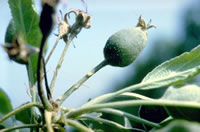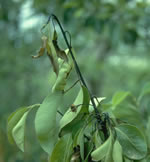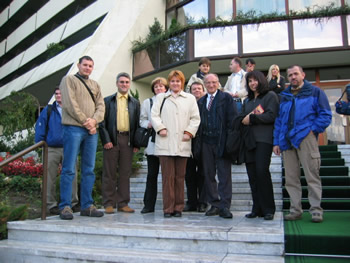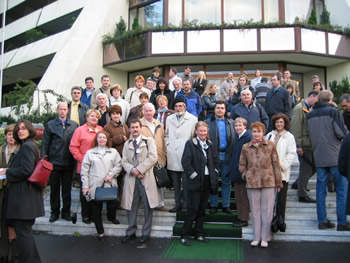
EPPO Conference on Fireblight
Budapest, 2003-10-07/09
At the kind invitation of the Hungarian Ministry of Agriculture and Rural Development, the EPPO Conference on Fireblight took place in Budapest, on 2003-10-07/09. Almost 70 specialists from 23 countries and a representative of the European Commission met to discuss the current fireblight situation in the EPPO region.
Main topics
Erwinia amylovora is native to North America and was introduced into northern Europe in the 1950s and 1960s. It continues to spread. The meeting heard reports of experiences with E. amylovora in different EPPO countries, from those with 17 years of experience to those with the first outbreaks of the disease. The present status of the disease in member countries was reviewed. The participants also learned about monitoring programmes, detection and management of fireblight in different countries, as well as about fireblight regulations and phytosanitary measures. Changes of the provisions that are laid down in Council Directive 2000/29/EC were the subject of a paper given by the EU representative. The last morning of the Workshop dealt with control methods against fireblight. Papers on prohexadione-Ca as an inducer of resistance and the use of streptomycin were presented. The controversy regarding the use of antibiotics was recognized. In the long term, resistance breeding appears as the most satisfactory solution for fireblight. In Hungary, an interesting research programme using traditional and commercial apple and pear cultivars as sources of resistance to fireblight was presented. The final paper approached yeasts as antagonists to fireblight, but more research is needed to study these antagonistic properties further.

Conclusions
The conference concluded that fireblight is an explosive disease, difficult to manage. By the time symptoms are recognized, the pathogen is well on its way to destroying orchards. Emphasis should be put on the development of disease management strategies. These could be defined as optimized combinations of different measures, such as: regular monitoring of fireblight host plants (including ornamentals), use of forecasting models or bioindicators (e.g. bees), information of the growers and the general public, use of healthy planting material, use of resistant/tolerant cultivars, prompt elimination of infected plants (or pruning of infected plant parts), appropriate control treatments, and implementation of phytosanitary measures (compulsory plant destruction, import inspections, plant passport system, protected zones). The whole legal system needs to be transparent and trusted. Once fireblight has been found, it is impossible to eradicate it completely. Movement of beehives may need to be regulated to avoid any further spread of the disease, as this risk has generally been underestimated. Finally, the Conference stressed that more research is needed on the epidemiology of fireblight to understand better its pattern of spread under European conditions, and in particular why the disease can ‘jump’ from an area to another. More studies are also needed on forecasting models and bioindicators (i.e. bees and pollen) as these can help in detecting infections as early as possible. Studies on control treatments which can be used against E. amylovora should also be pursued.



